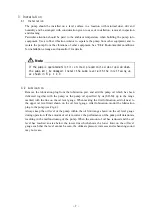
- 14 -
4.2 Start of operation
To start operation, close leak valve (B), open vacuum valve (A) to the inlet port, and turn on the
power switch. Then the pump starts beings to exhaust (see Fig. 5).
①
Firing hazard. Do not touch the motor or the pump body as these surface
temperature should be higher (40~80℃).
② If operation is performed at high pressure, oil mist is generated at the
outlet side. Install an oil mist trap or connect a duct to discharge the
oil mist outside the room. Or, install a ventilator.
When the pump does not rotate correctly, take the following measures.
a) Check the amount of oil, and adjust if necessary.
b) In an environment where the ambient temperature is low, if the pump is
left unused for a long time (three days or longer), the pump oil enters
the cylinder. (This phenomena cannot be avoided even if the pump pressure
is released to atmospheric pressure after last using the pump.) If the
pump is restarted in this condition, an overload is applied to the pump
and the overload protector may actuate. In such a case, turn the pump on
and off several times in short intervals.
After operating the pump for several hours, oil temperature inside the pump may
be risen up to 70~80℃. If the temperature is over this, the pump may have
troubles. Maintain the pump, or contact
us.
4.3 Stopping the operation
To stop operation, close vacuum valve (A), open leak valve (B) quickly, and turn the power
switch off (see Fig. 5).
Do not stop and restart this equipment repeatedly. When restarting this
equipment, make sure that the pump (motor) has stopped completely before
turning on the power. If the pump (motor) has not stopped completely and the
equipment is restarted, the pump’s (motor) current rises and either the
protection device is activated or the motor may become damaged.
Firing hazard. As the surface of the pump body is higher temperature(40~80℃)
during operation, do not touch it until cooled down after stopping the pump.
Caution
Note
Note
Caution
Caution
















































